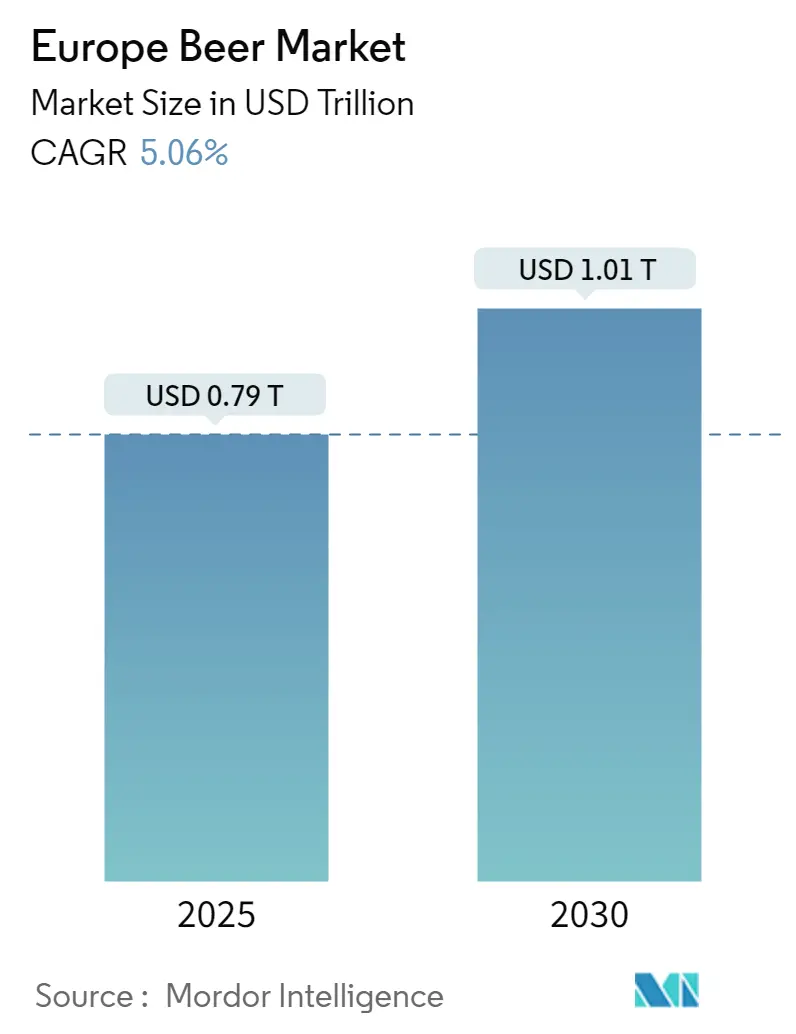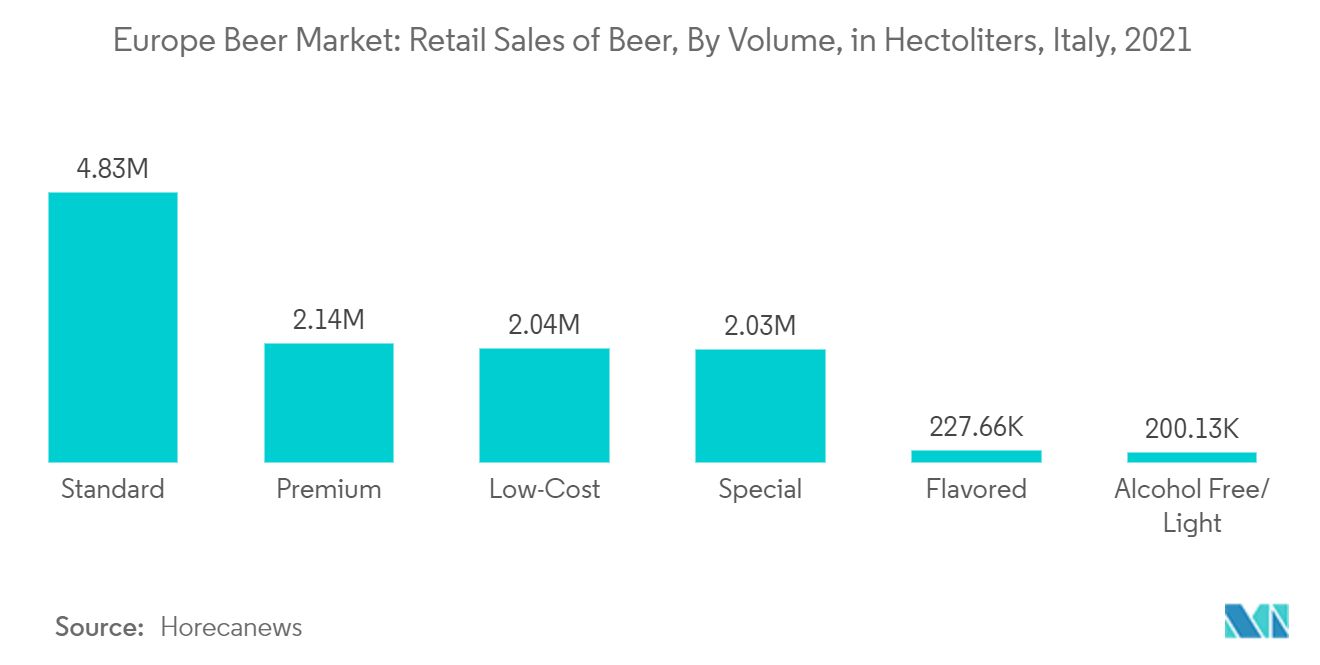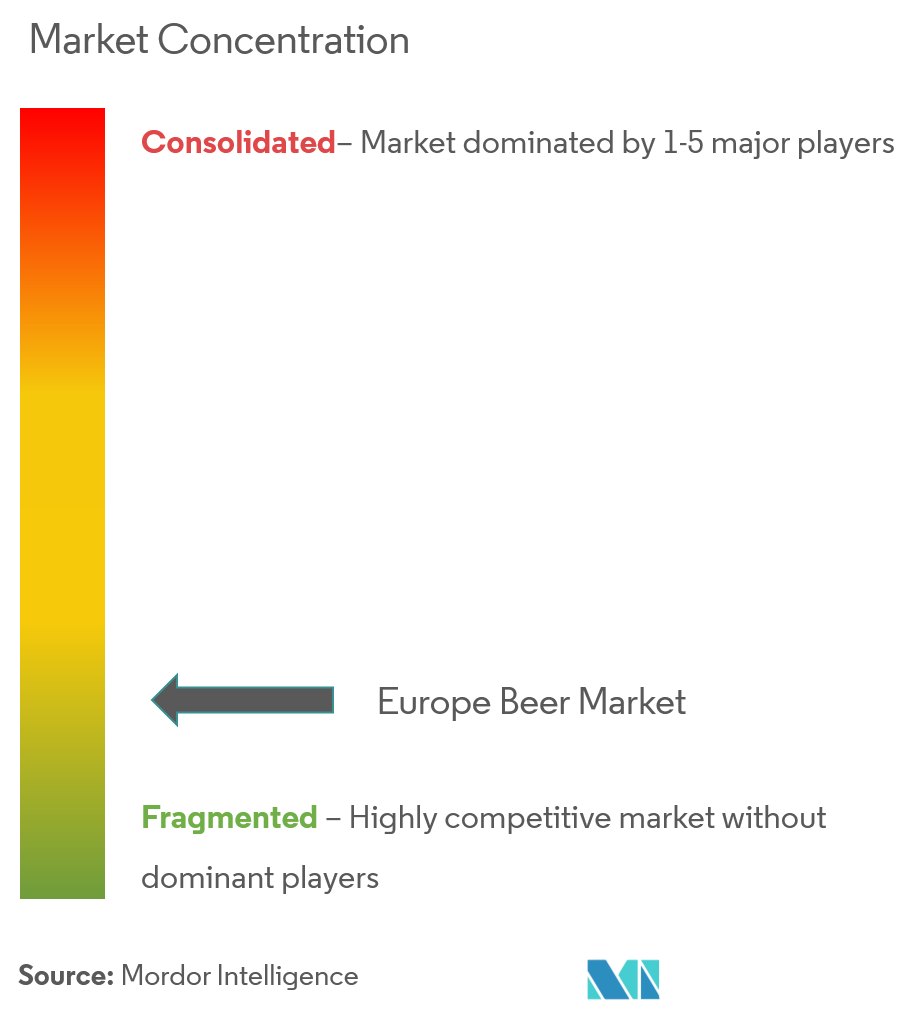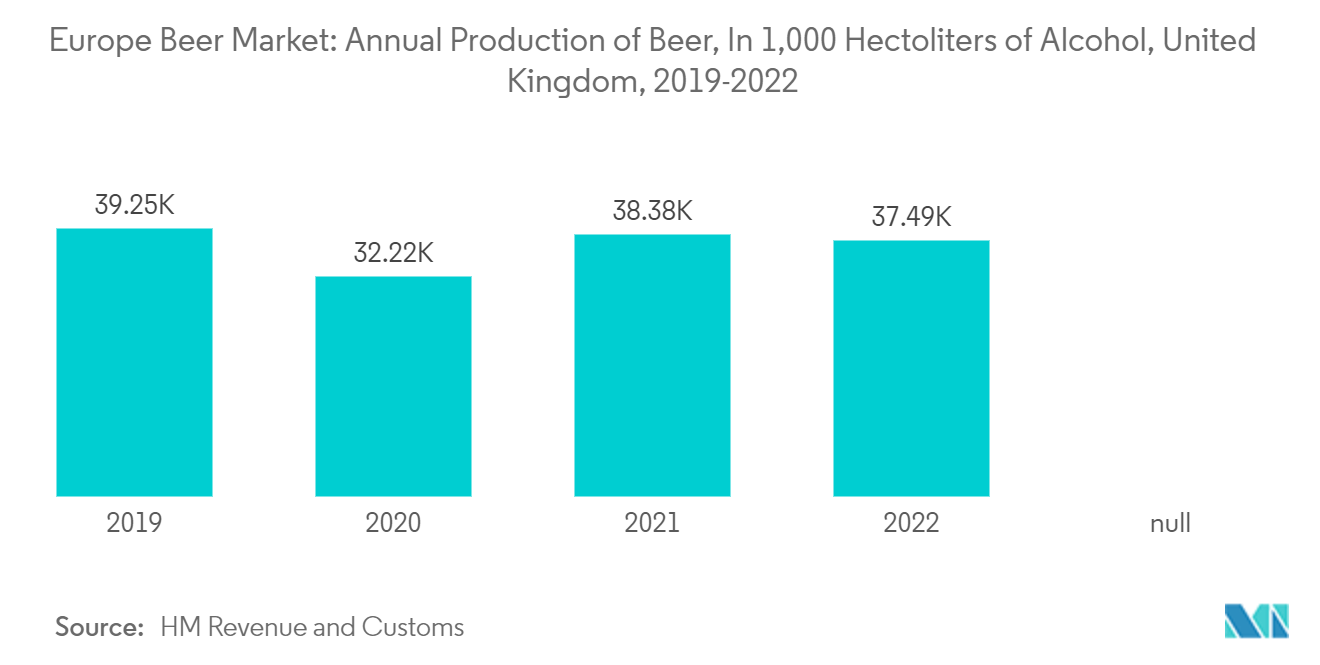
| Study Period | 2019 - 2030 |
| Base Year For Estimation | 2024 |
| Forecast Data Period | 2025 - 2030 |
| Market Size (2025) | USD 0.79 Trillion |
| Market Size (2030) | USD 1.01 Trillion |
| CAGR (2025 - 2030) | 5.06 % |
| Market Concentration | Low |
Major Players.webp)
*Disclaimer: Major Players sorted in no particular order |
Europe Beer Market Analysis
The Europe Beer Market size is estimated at USD 0.79 trillion in 2025, and is expected to reach USD 1.01 trillion by 2030, at a CAGR of 5.06% during the forecast period (2025-2030).
The major drivers for the European beer market are changing lifestyles, consumption habits regarding alcoholic drinks, an increase in disposable incomes, and the popularity of beer among the younger generation. For instance, according to the Office for National Statistics (UK), the gross domestic product per head in the United Kingdom was GBP 33,497 in 2022. Innovative products, such as flavored and crafted beer, and the growing demand for imported beer are some of the opportunities for players in the market studied. Consumers are more interested in low to no-alcohol beers, giving a broad scope to the market. Europe has long been regarded as a desirable travel destination because of its diversity of cultures, traditions, and languages. According to the UNWTO Tourism Data Dashboard, approximately 303.1 million tourists arrived in Europe in 2021. Hence, most tourists prefer trying the regional beers available across the region, thereby driving the market studied.
Furthermore, the growing disposable incomes of consumers in Eastern European economies and increases in the demand for healthy versions of beer are expected to make this region more fruitful for the future growth of the market studied. The larger segment is expected to witness steady growth in Eastern Europe during the forecast period. Major companies are engaging in research and development to understand the changing demands of consumers and create innovative products. For instance, in May 2022, the first House of Peroni Nastro Azzurro in Italy began operation in Rome. The idea was inspired by arguably one of the most popular super-premium Italian beers in the world, which is claimed to represent genuine Italian style, taste, and culture. It is also gaining significant popularity among millennials and Gen Z due to its diverse formulations, flavors, and flavor offerings, which have helped propel the market's growth.
Europe Beer Market Trends
Increasing Demand for Alcoholic Beverages
The rising demand for alcoholic beverages is driving the growth of the European beer market. Europeans have sophisticated palates, which results in the demand for high-quality beverages. The demand for beer is prominent in the market studied, and the drink caters to the surging demand for alcoholic beverages. The changing lifestyle of consumers and high disposable incomes have increased the demand for beer. The rise in beer consumption is mostly associated with the trend growing among youngsters. Moreover, government guidelines add weight to the sales of alcoholic beverages. Consumers in the United Kingdom are opting for high-quality, high-volume convenience beer. According to the Office of the National Statistics (UK), consumer spending on beer in the United Kingdom stood at GBP 6,423 million in 2022. Lager, pale ale, and bitter are becoming increasingly popular with consumers. Indian Pale Ale (IPA) is loved by consumers. It is enhanced with floral and fruity hop varieties added to appeal to modern taste.
Craft beer has become extremely popular among young consumers. Craft beer allows customers to explore a wide range of beer types and flavor characteristics. There is a growing trend for low-alcohol-by-volume drinks, and sales of no-alcohol or low-alcohol beers have increased as a result of increased interest from health-conscious customers, as well as a greater selection of new varieties with superior flavors. The rising number of breweries also contributes to the growth of the market studied. For instance, according to the UHY Hacker Young, there were approximately 2,426 breweries in the United Kingdom in 2022. The major players across the region are mainly focusing on innovative product launches and expansions. For instance, in November 2022, Beerwulf, an online beer retailer owned by Heineken, launched its marketplace in the Netherlands, wherein third-party retailers can also launch their products. The platform offers products from small breweries and established retailers.
Rise of Distribution Through Off-trade Channels
The off-trade distribution channel adds to the increasing beer sales in the European market. The off-trade channel consists of supermarkets/hypermarkets, online retail, and other mediums that have generated a major portion of beer sales in recent times. These segments are growing year after year at a faster pace, owing to the wide variety of options available to consumers. The added convenience and price gap in comparison to on-trade channels have added to the demand further. The organized shelves of supermarkets/hypermarkets aid consumer convenience in buying beer in the European region. The wide range of products available, coupled with well-informed staff, is adding value to the cause.
Furthermore, people are more interested in consuming beer at home, which further adds to the surging sales through off-trade channels. The major players in the market are also catering to these channels to increase their sales. Customers are shifting the way they shop and prefer online channels more. Heineken boosted its investment in e-commerce with a focus on its Beerwulf, GLUP, and Drinkies platforms to adapt to these changing consumer behaviors. The momentum during on-trade closures and the successful sales of the Blade, a beer tap for home use, and small retail establishments that provide high-quality draught beer in 8-liter brewery-fresh containers have been key drivers of growth for Beerwulf. Breweries are looking for brand collaborations to create crossover audiences and attract drinkers and media attention. For instance, in February 2022, Molson Coors launched Madri lager into grocery stores and supermarkets in the United Kingdom to enhance its share in the off-trade beer category. Similarly, in November 2021, Asda became the first UK supermarket to launch a draught beer concept.

Europe Beer Industry Overview
The European beer market is highly competitive, with the presence of global, regional, and local players. The market is fragmented, and the key players are focused on increasing their share in the beer market. Some of the major players in the European beer market are Asahi Group Holdings Ltd, Anheuser Busch InBev, Bitburger Brewery, Carlsberg Group, and Heineken NV, among others. The global and regional players in the market focus on understanding consumers' changing demands and creating products per their needs. Market players prefer product innovation mergers and collaborations to expand their presence globally with a variety of products. For instance, in June 2022, AB InBev launched a new non-alcoholic beer, Corona Cero, across Europe, and it is available in Germany as well. The beer is brewed with 100% natural ingredients. The launch adds to the company’s rising portfolio of no- and low-alcohol beers and is an important milestone in brewers' smart drinking ambitions in Germany.
Europe Beer Market Leaders
-
Asahi Group Holdings Ltd
-
Bitburger Brewery
-
Carlsberg Group
-
Anheuser Busch InBev
-
Constellation Brands
- *Disclaimer: Major Players sorted in no particular order

Europe Beer Market News
- December 2023: AB-InBev expanded its product portfolio in the United Kingdom with the launch of a new 4.5 percent ABV Italian-style lager, Via Roma, exclusively at the supermarket chain Sainsbury’s.
- June 2023: The Brewers Association expanded its product portfolio in the United Kingdom by launching six American craft breweries featuring 14 different beers, eight of which have been unavailable in the United Kingdom.
- April 2023: Heineken launched its Spanish lager brand Cruzcampo on draught into pubs and bars across the United Kingdom. As per the brand, Cruzcampo is brewed at Heineken’s “Royal Brewery” in Manchester, essentially making the beer a British beer but simply using its Spanish branding.
- March 2023: Carlsberg Marston’s Brewing Company launched Carlsberg 0.0 across the United Kingdom. According to the company’s claim, Carlsberg 0.0 has been specifically brewed as an alcohol-free beer, meaning it delivers everything beer drinkers expect from a well-balanced Pilsner – refreshing, with a crisp, hoppy bite – just crafted to contain zero alcohol.
- January 2023: Asahi Europe & International launched its alcohol-free beer, Asahi Super Dry 0.0% across the United Kingdom. The company states that the beer is available in bars and restaurants and sold individually and in multipacks.
Europe Beer Industry Segmentation
Beer is a popular alcoholic beverage that is widely preferred across the globe. It is a carbonated and fermented drink prepared with malted cereal grains, having malt flavor with hops. The European beer market is segmented by product type, distribution channel, and geography. Based on product type, the market is segmented into ale, lager, and other product types. On the basis of distribution channels, the market is segmented into on-trade and off-trade. By geography, the market is segmented at a country level into the United Kingdom, France, Spain, Italy, Germany, Russia, and Rest of Europe. The report offers the market size in value terms in USD for all the abovementioned segments.
| Product Type | Ale |
| Lager | |
| Other Product Types | |
| Distribution Channel | On-trade |
| Off-trade | |
| Geography | United Kingdom |
| France | |
| Spain | |
| Italy | |
| Germany | |
| Russia | |
| Rest of Europe |
Europe Beer Market Research FAQs
How big is the Europe Beer Market?
The Europe Beer Market size is expected to reach USD 0.79 trillion in 2025 and grow at a CAGR of 5.06% to reach USD 1.01 trillion by 2030.
What is the current Europe Beer Market size?
In 2025, the Europe Beer Market size is expected to reach USD 0.79 trillion.
Who are the key players in Europe Beer Market?
Asahi Group Holdings Ltd, Bitburger Brewery, Carlsberg Group, Anheuser Busch InBev and Constellation Brands are the major companies operating in the Europe Beer Market.
What years does this Europe Beer Market cover, and what was the market size in 2024?
In 2024, the Europe Beer Market size was estimated at USD 0.75 trillion. The report covers the Europe Beer Market historical market size for years: 2019, 2020, 2021, 2022, 2023 and 2024. The report also forecasts the Europe Beer Market size for years: 2025, 2026, 2027, 2028, 2029 and 2030.
Our Best Selling Reports
Europe Beer Industry Report
Statistics for the 2025 Europe Beer market share, size and revenue growth rate, created by Mordor Intelligence™ Industry Reports. Europe Beer analysis includes a market forecast outlook for 2025 to 2030 and historical overview. Get a sample of this industry analysis as a free report PDF download.





